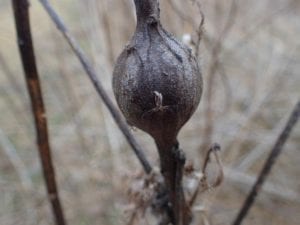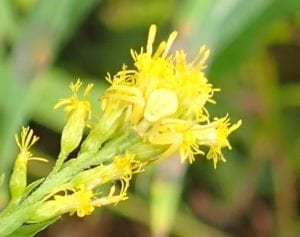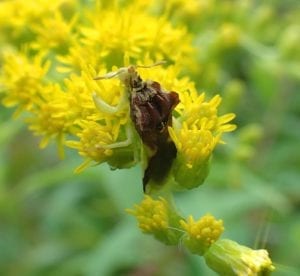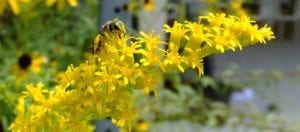Originally published in the Easton Irregular —
Autumn is approaching, and so my thoughts turn to goldenrod. Companion to milkweed and ragweed, it colors our fields with late season yellow, each stem containing a multitude of tiny nectar-filled flowers, which fluff into seeds that attract a long list of birds. A field full of goldenrod is a field full of life.
I have made a practice, over the past few years, of visiting these fields of gold to see what fascinating things I might find. Goldenrod is an education in ecology. It has taught me to go beyond the question, “What’s eating my plant?” toward an understanding of the relationships between plants and insects, predators and prey.
Ecosystem Engineers
Galls, abnormal growths of plant tissues, are common on goldenrod. A round gall, which looks just like it sounds, occurs when a fly lays eggs in the terminal leaf bud of a goldenrod plant. When an egg hatches the larva chews into the stem, its saliva stimulating the plant to form a swelling, rich in protein and starch, that will provide it with sustenance for the better part of a year. Eventually the fly larva chews an exit hole from which it will emerge as an adult the following spring… provided it’s lucky enough to avoid predators. A woodpecker or chickadee may peck open the gall and extract the juicy larva. Or a tiny wasp might penetrate the gall with its ovipositor, so that its babies can consume the fly larva and take possession of the space.
A flower gall, also aptly named, is caused by a tiny midge laying its eggs on a leaf bud, which stimulates bunched up growth. Pull one of these bunches open and you’ll learn why this midge is known as an “ecosystem engineer.” You’ll likely find all kinds of life—other midges, spiders, tiny beetles, and more—in the crevices created by the gall.
An abundance of galls might reduce the flowering, and therefore the seed production, of goldenrod. So the plants have developed an ingenious strategy: In spring, the tender stems of some young goldenrod plants duck, that is, they bend toward the ground, confusing the egg laying flies. Later in the summer, once the flies have finished laying eggs, the stems straighten up and produce their bounty of tiny blooms.

Fields of Canada goldenrod (Solidago canadensis) are beautiful, but this is not the species you want in your garden, as it is a spreader. Instead, plant a non-spreading type, such as S. rugosa, S. caesia, or one of the well-behaved hybrids.

Round galls house gall fly larvae. If you find one, let it stand until spring, when the adult gall fly will leave its protective quarters.
Why We Need Plant Eaters
Goldenrod is also host to myriad miners, chewers, suckers, and stipplers. This does not seem to affect the vigor of the plants in the least. Lift a leaf and you may spot lacebugs. Open up a flower gall and you’ll be likely to find the adult phase of the goldenrod leafminer, or a tiny treehopper. Look closely at a tender stem and you will undoubtedly find aphids. Brown patches on leaves indicate the presence of tiny larvae feeding between the upper and lower surfaces of the leaves. All of these plant eaters can be seen as beneficial, despite the minor damage they cause. Why? Because they are prey for predators. And predators keep the balance in our gardens.
Goldenrod is a late summer feast of nectar and pollen. It is not the culprit that causes such misery for hay fever sufferers. Bees, flies, moths, beetles, and wasps of many kinds can be found congregating on the densely packed flowers. Its pollen is sticky, not powdery and windblown like ragweed pollen—the real culprit. Many of goldenrod’s pollinators, including wasps, tachinid flies, goldenrod soldier beetles, lady beetles, and more, are also predators.
Hidden in Plain Sight
My favorite goldenrod sightings are the intrepid hunters, particularly those that are masters of camouflage. Some predators, such as ambush bugs, spiders and carnivorous wasps, are generalists; others, such as lady beetles, are more specific; and still others, notably the wasp parasitoids, target specific hosts. Spotting the small but mighty goldenrod spider is a challenge, as its coloration has evolved to exactly match the flower buds it patiently patrols. It can even change from yellow to white as the situation warrants. Likewise, an ambush bug blends in perfectly with its surroundings as it waits to snatch its prey with its knife-like pincers and then subdues it by injecting it with venomous saliva. It then sucks the life out of it. Now that’s drama!
Take the goldenrod challenge.
See how many insects you can photograph and identify on this one species. You’ll be amazed. It may even prompt you to see your garden as a community of plants and insects, rather than as a decorative landscape feature. This can completely change the way you care for it. But that’s a topic for another column.
Bio: Horticulturist and writer Pam Ruch, caretaker of the Nurture Nature Center Urban Recycle Garden, tends gardens in the Lehigh Valley and beyond, and presents gardening and nature journaling programs throughout the region.





